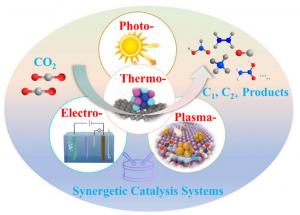Dual-energy catalysis open new pathways to carbon recycling
GA, UNITED STATES, October 16, 2025 /EINPresswire.com/ -- Converting carbon dioxide into fuels and chemicals using renewable energy is a promising route to reduce greenhouse gas emissions and recycle carbon. Yet the stability of CO2 molecules makes their activation both energy-intensive and inefficient when relying on a single energy input. Recent research highlights the power of coupling multiple energy sources—such as light with heat, electricity with heat, or plasma with thermal energy—to generate synergistic effects that improve efficiency, selectivity, and stability. By integrating these complementary modes of energy, synergetic catalytic systems open opportunities to overcome barriers in CO2 reduction and move closer to practical, scalable carbon recycling technologies.
Carbon dioxide reduction is central to achieving carbon neutrality, but it remains hindered by strong chemical bonds and sluggish reaction kinetics. Conventional catalytic approaches—including thermocatalysis, photocatalysis, electrocatalysis, and plasma catalysis—have achieved important progress yet face limitations such as high energy consumption, poor selectivity, or insufficient product yields. These challenges have spurred interest in hybrid systems that combine multiple energy inputs. The rationale is that the simultaneous or sequential use of light, heat, plasma, and electricity can activate reactants, intermediates, and catalysts more effectively than single modes alone. Based on these challenges, there is a pressing need to explore synergetic energy-coupled catalysis for CO2 reduction.
A research team from Shenzhen University of Advanced Technology and collaborators has published a comprehensive review (DOI: 10.1016/j.esci.2024.100306) on synergetic energy-coupled catalytic systems for CO2 reduction. The article appeared online on May 2025, in eScience. The review examines how integrating thermal, photonic, electrical, and plasma energies into catalytic systems creates synergistic effects that significantly enhance CO2 conversion efficiency. By analyzing recent advances, mechanisms, and challenges, the study provides insights into how such strategies can accelerate the transition toward sustainable energy and carbon recycling solutions.
The review categorizes energy-coupled systems into photothermal, electrothermal, and plasma-thermal approaches. Photothermal catalysis combines light and heat, maximizing use of the solar spectrum while lowering the high energy demands of standalone thermocatalysis. For instance, photo-assisted thermocatalysts such as Au/ZnWO4–ZnO and Ni/TiO2 have demonstrated high selectivity for CO2 hydrogenation under mild conditions with improved efficiency. Electrothermal systems use resistive heating from electrical currents to accelerate CO2 methanation and related reactions. Methods like electric internal heating (EIH) allow catalysts to reach reaction temperatures within minutes, enhancing efficiency and reducing poisoning. Plasma-thermal coupling exploits nonthermal plasmas that produce energetic electrons and radicals under mild conditions, which when paired with nanostructured catalysts achieve high CO2 conversion at lower energy costs. Case studies include β-Mo2C nanorods with enhanced CO selectivity and plasma-assisted chemical looping achieving threefold higher conversion than conventional methods. Collectively, these synergetic systems demonstrate that multi-energy inputs can overcome barriers of low kinetics, poor selectivity, and high energy requirements, providing a versatile platform for sustainable CO2 utilization.
“Single-mode catalytic strategies for CO2 reduction may have reached their performance limits,” said Professor Hui-Ming Cheng and Professor Xiaolong Zhang, co-authors of the review. “By leveraging the synergetic effects of combined energy inputs, we can access new reaction pathways, increase selectivity for valuable products, and significantly reduce energy consumption. This approach not only advances the science of catalysis but also accelerates the deployment of technologies needed for carbon neutrality. The development of hybrid energy-driven systems represents a paradigm shift for future CO2 conversion research.”
Synergetic energy-coupled catalytic systems hold promise for both environmental remediation and clean energy production. By making CO2 reduction more efficient and selective, these systems enable the sustainable production of fuels like methanol, methane, and multi-carbon hydrocarbons, as well as industrially relevant chemicals such as ethanol and acetic acid. Beyond carbon recycling, these hybrid catalytic approaches provide a blueprint for harnessing renewable electricity and solar energy more effectively in chemical manufacturing. If scaled successfully, they could bridge the gap between laboratory research and industrial application, offering a viable pathway to reduce greenhouse gas emissions and achieve long-term carbon neutrality goals.
DOI
10.1016/j.esci.2024.100306
Original Source URL
https://doi.org/10.1016/j.esci.2024.100306
Funding information
The authors gratefully acknowledge financial supports from the National Natural Science Foundation of China (52201237), Shenzhen Science and Technology Innovation Bureau (KQTD2022110109364705, ZDSYS20210706144000003), the China Postdoctoral Science Foundation (E325281005 and E325281003), the Joint Research Project of China Merchants Group and SIAT (E2Z1521) and the Cross Institute Joint Research Youth Team Project of SIAT (E25427).
Lucy Wang
BioDesign Research
email us here
Legal Disclaimer:
EIN Presswire provides this news content "as is" without warranty of any kind. We do not accept any responsibility or liability for the accuracy, content, images, videos, licenses, completeness, legality, or reliability of the information contained in this article. If you have any complaints or copyright issues related to this article, kindly contact the author above.

